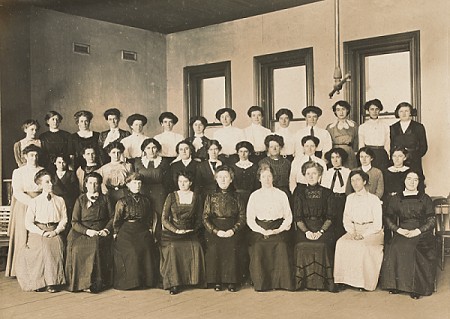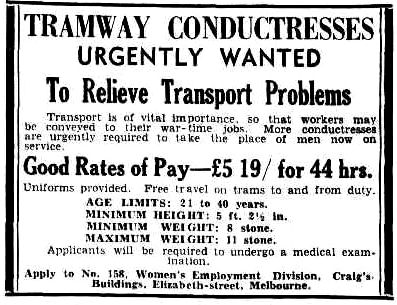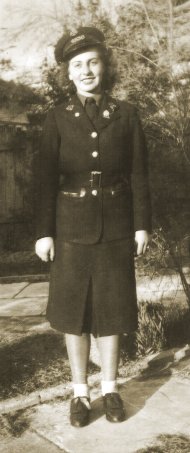Melbourne Tram Museum
- Follow Melbourne Tram Museum on Twitter
- Follow Melbourne Tram Museum on Facebook
- Follow Melbourne Tram Museum on Instagram
- Follow Melbourne Tram Museum on Pinterest
- Follow Melbourne Tram Museum on Tumblr
- Subscribe to Melbourne Tram Museum's RSS feed
- Email Melbourne Tram Museum
Women in the tramways
The Melbourne tramway system and its attitude to female employees was very much a product of the Victorian era, when there were very definite ideas about what was suitable work for women. This was tied up with the then current beliefs about the delicacy of women, and their need to be protected from the rough and tumble of life.
Given the nature of most of the jobs within the cable tram system, there was some validity in this view. Many jobs required a reasonable amount of physical strength (such as gripmen) or agility (conductors), which precluded female employees, particularly given the state of feminine fashions of the time.
In fact, there was only one job that women were allowed to occupy in the Melbourne Tramway & Omnibus Company (MTOC). When a conductor finished his shift, he turned in his bell punch along with his takings. The women’s job was to open the bell punch and empty out the clippings of different coloured card (corresponding to different fares) onto a counting table. The women then counted out the clippings and reconciled them against the conductor’s takings.
 Ladies
on staff at MTOC, June 1912.
Ladies
on staff at MTOC, June 1912. - Photograph courtesy State Library Victoria / J.G. Roberts.
There was considerable opposition from male employees (and the ATMOEA) against the hiring of female employees. This was due to women being paid only two-thirds of the adult male wage for the same work, so female employees were viewed as endangering male entitlements.
This remained the case for many years. It was not until the First World War that tramway companies began to consider a wider role for women in the workforce, primarily as conductresses. This was driven by the shortage of manpower due to the absence of many men on active service.
However, the nature of tramcar design at the time required conductors to ‘tread the boards’ to collect fares – which involved swinging along the footboards outside the tramcar – as the passenger compartments did not have a continuous aisle through the length of the car. This was thought to be too dangerous a job for women. Therefore, the PMTT modified one of its maximum traction tramcars (No 36, later the solitary D class car) by cutting an aisle through the full width seats in the drop-centre of the car, for potential use by conductresses. This experiment did not come to fruition, and there matters rested for some time.
It was not until the Second World War that conductresses began employment with the M&MTB in August 1941, due to severe manpower shortages. This was possible, as the changes in tramcar design (exemplified by the various incarnations of the W class) did not provide the obstacles to use of conductresses that formerly existed. Preference was given to wives of M&MTB employees on active service, followed by wives of other servicemen.
 Advertisement
from The Age, 7 October 1944.
Advertisement
from The Age, 7 October 1944. - Image courtesy National Library of Australia.
However, in order to protect the rights of male conductors and ensure that they were not dismissed in favour of female staff, the ATMOEA fought to ensure that female conductresses were paid adult male rates – the first time this had been achieved in Australia for any category of female worker.
 Mrs
H.F. Scott in M&MTB conductress’ uniform (1942).
Mrs
H.F. Scott in M&MTB conductress’ uniform (1942). - Photograph courtesy Mrs D.C. Jones.
The author’s late aunt, Mrs Hazel F. Scott, was one of the first conductresses to join the M&MTB. Allocated to Hawthorn Depot, she recounted in later years many amusing incidents of her time with the tramways, often saying it was the best job she ever had. However, with the return of ex-servicemen from the war in 1945, the conductresses were laid off (including my aunt), much to their disgust.
The burgeoning post-war economy did not allow this situation to continue, as many other employment opportunities opened up, causing many male staff members to take up higher paying jobs elsewhere. This led the M&MTB to re-hire many of its former conductresses only a couple of years after their dismissal, despite union opposition.
 Conductress
changing the destination sign on VR tram, St Kilda to Brighton route
(1943).
Conductress
changing the destination sign on VR tram, St Kilda to Brighton route
(1943). - Photograph courtesy State Library of Victoria.
The M&MTB faced some major difficulties during the 1950s, particularly with regard to staff shortages. Increasing its use of female personnel was viewed as an opportunity to address this problem, so in 1955 M&MTB management ordered two conductresses to start driver training. All hell broke loose, with stop-work meetings being held the same day they reported for training, leading to immediate strike action. Management withdrew the prospective female drivers from training in order to avert further industrial action.
It was not until the 1970s and the climate ushered in by the Whitlam Federal Government that this situation changed, with a new spirit of inclusiveness and equal opportunity for all Australians. There was considerable pressure from conductresses to access higher paid driving jobs, so a union meeting was held in 1975 to discuss the matter.
The leadership of the ATMOEA was still mired with the attitudes of the 1950s, which held that women were a threat to the careers of male employees, as a man’s prime role in society was to be the family breadwinner. The thought that women could perform jobs traditionally reserved for men was anathema to them – as well as taking away opportunities for promotion. In effect, the growth of feminism had passed them by.
Much rancorous discussion was held at this union meeting, until Joyce Barry stood up and uttered the immortal line, “I don’t need a penis to drive a bloody tram!” This single statement swept away all union opposition to the proposal by exposing the moral bankruptcy of the status quo and opening it to ridicule. This enabled the M&MTB to implement an equal opportunity employment policy, and she became the first female tram driver in Melbourne.
Ms Barry’s action in overcoming this barrier (in somewhat startling fashion) enabled women to aspire to fill any role in Melbourne’s tramway system, and publicly advanced the cause of sexual equality in the workplace in Australia – particularly as female tram drivers were highly visible to the general populace.
Bibliography
The Age (1944), Advertisements, 7 October 1944, page 4.
Pearsall, R (1992) History of the ATMOEA, Rail, Tram & Bus Union
NSW
M&MTB Annual Reports